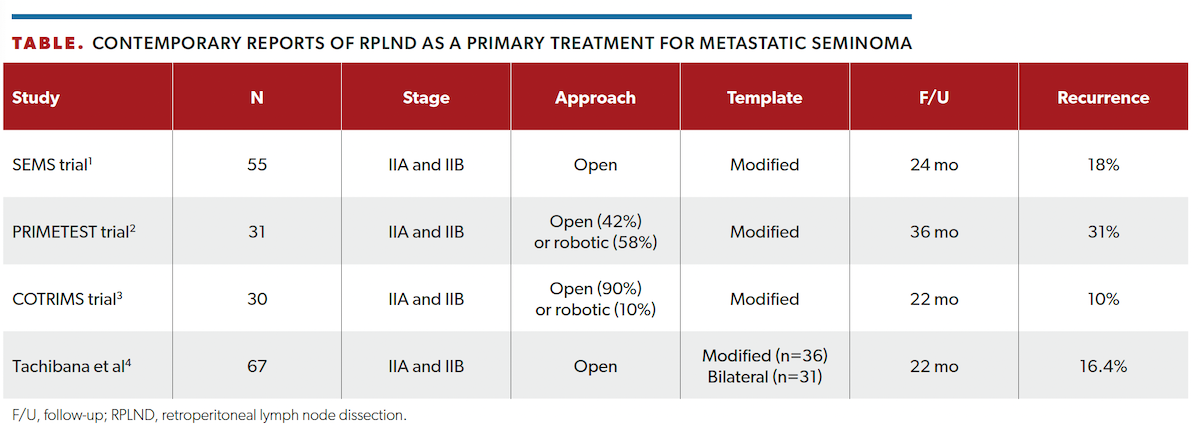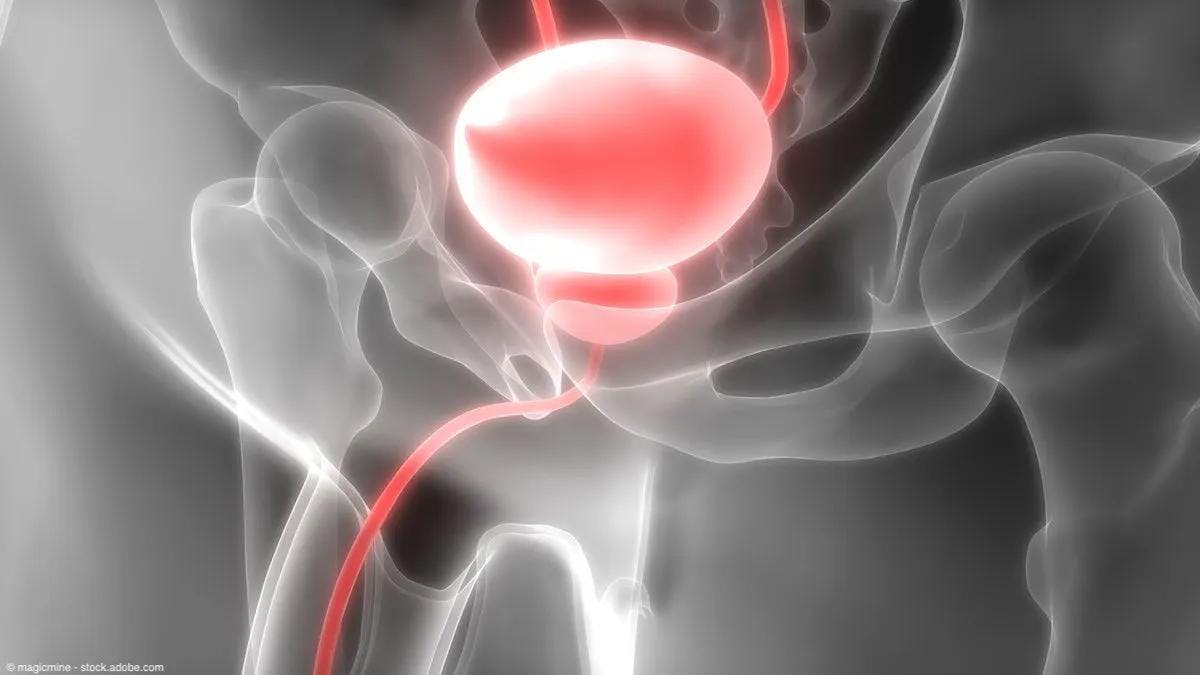Feature
Article
Urology Times Journal
The role of surgery continues to evolve in seminoma
Author(s):
"RPLND is an attractive option for those who prefer to avoid chemotherapy," write Jiping Zeng, MD; Timothy A. Masterson, MD; and Clint Cary, MD, MPH, MBA.

Zeng is a urologic oncology fellow at Indiana University School of Medicine in Indianapolis. Masterson is an associate professor of urology at Indiana University School of Medicine. Cary is the director of the Urologic Germ Cell Tumor Program and an associate professor and chair of urology at Indiana University School of Medicine.
Retroperitoneal lymph node dissection (RPLND) has undergone significant refinement and is associated with fewer perioperative comorbidities. In the past, the preferred treatment modalities for metastatic seminoma included systemic chemotherapy and radiation. However, findings from survivorship studies have revealed the long-term sequelae of chemotherapy and radiation. There is an emerging need for alternative treatment options, especially for low-stage metastatic seminoma. RPLND is an attractive option for those who prefer to avoid chemotherapy.

Efficacy of Primary RPLND in Stage II Seminoma
To date, 3 prospective trials, including SEMS (NCT02537548),1 PRIMETEST (NCT02797626)2, and COTRIMS3, have evaluated the efficacy of RPLND in patients with early stage II seminoma. Pooling a total of 118 patients, the 2-year recurrence-free survival (RFS) without adjuvant therapy is approximately 70% to 90%. Our center published a large retrospective series including 67 patients and reported a 2-year RFS rate of 82% (Table).4 As a result, the American Urological Association (AUA) and National Comprehensive Cancer Network (NCCN) have updated their guidelines for testicular cancer and suggest that primary RPLND is an option for stage II seminoma.5,6 In our experience, it appears that those who present with stage I seminoma initially and have disease that takes longer than 12 months to develop retroperitoneal metastasis are more likely to be cured by RPLND alone with long-term follow-up.4
Recurrence Pattern and Salvage Therapy
From the prospective trials and our experience at Indiana University (IU), we observed that most of the recurrences (>80%) occurred within 2 years following RPLND. This reiterates the importance of continued surveillance after RPLND to catch recurrences early. The locations of recurrence vary, including retroperitoneum, pelvis, mediastinum, and supraclavicular region. Most commonly, patients will be given systemic chemotherapy either with 3 cycles of bleomycin, etoposide, and cisplatin or 4 cycles of etoposide and cisplatin, which almost always eradicates the disease completely. Occasionally, patients may elect to undergo another surgery such as pelvic LND if the recurrence is localized in the pelvis and there is no evidence of systemic disease elsewhere. In our experience, repeat surgery is effective and could be offered to select patients.
Lymph Node Mapping and Template
The current template used is extrapolated from the mapping study of nonseminomatous germ cell tumors (NSGCTs). Theoretically, pure seminoma does not possess any choriocarcinoma component, which is known for hematogenous spread. Thus, seminoma metastasizes almost exclusively through the lymphatic system. The lymphatic drainage should mimic the drainage in NSGCT in the retroperitoneum. Our unpublished data suggest that the predominant retroperitoneal landing zone is para-aortic for left-sided and interaortocaval (IAC) for right-sided primary tumors.
Crossover is of high interest to surgeons who are deciding the template at the time of RPLND. The crossover, defined as microscopic positive nodal deposition in the IAC zone for left-sided primary tumors and in the para-aortic zone for right-sided primary tumors, occurred in 5% to 11% of patients in our experience (data to be published). This is seemingly higher than that observed in NSGCTs. We have previously reported the long-term follow-up results using modified template RPLND as the primary treatment for metastatic NSGCTs and found a 1.6% contralateral recurrence.7 We suspect that our seminoma cohort is limited to stage II, and there were almost no patients with pN0 disease. This might explain the higher crossover rate. However, additional mapping of retroperitoneal metastatic locations is needed to fully elucidate the landing zones in stage II seminoma due to the possibility of subtly different nodal drainage patterns between seminoma and nonseminoma.
With the available data, we are currently performing bilateral template dissections on all patients with stage II seminoma until further data are accrued. However, based on our published retrospective series, patients who have disease in the typical landing zone that takes longer than 12 months to develop retroperitoneal metastasis could be candidates for unilateral templates.
Complications
The surgery is associated with an acceptable safety profile, with a complication rate of 4.5% within 30 days in the IU cohort.4 The complication profile would be expected to be similar to that of patients undergoing RPLND for NSGCTs. Most of the complications are mild, such as ileus. The application of the enhanced recovery after surgery pathway in patients with testicular cancer has shown benefits. The median length of stay is 3 days, which is significantly shorter than historical reports where the median length of stay was 6 days in primary RPLND. Perhaps the most undesired complication is chylous ascites, with an incidence of 1.9%, comparable to primary RPLND in NSGCTs, where an incidence of 0.2% to 2.1% is reported.8
Summary
RPLND is an effective and safe treatment option for early stage II seminoma and has been added as a treatment option in both the AUA and NCCN guidelines. Salvage chemotherapy is effective in eradicating the disease if there is recurrence. The dissection template will continue to be studied. As long-term follow-up data continue to mature, RPLND should be offered as an option in high-volume RPLND centers.
REFERENCES
1. Daneshmand S, Cary C, Masterson T, et al. Surgery in early metastatic seminoma: a phase II trial of retroperitoneal lymph node dissection for testicular seminoma with limited retroperitoneal lymphadenopathy. J Clin Oncol. 2023;41(16):3009-3018. doi:10.1200/JCO.22.00624
2. Heidenreich A, Paffenholz P, Hartmann F, Seelemeyer F, Pfister D. Retroperitoneal lymph node dissection in clinical stage IIA/B metastatic seminoma: results of the COlogne trial of retroperitoneal lymphadenectomy in metastatic seminoma (COTRIMS). Eur Urol Oncol. 2024;7(1):122-127. doi:10.1016/j.euo.2023.06.004
3. Hiester A, Che Y, Lusch A, et al. Phase 2 single-arm trial of primary retroperitoneal lymph node dissection in patients with seminomatous testicular germ cell tumors with clinical stage IIA/B (PRIMETEST). Eur Urol. 2023;84(1):25-31. doi:10.1016/j.eururo.2022.10.021
4. Tachibana I, Alabd A, Tong Y, et al. Primary retroperitoneal lymph node dissection for stage II seminoma: is surgery the new path forward? J Clin Oncol. 2023;41(23):3930-3938. doi:10.1200/JCO.22.01822
5. Stephenson A, Bass EB, Bixler BR, et al. Diagnosis and treatment of early-stage testicular cancer: AUA guideline amendment 2023. J Urol. 2024;211(1):20-25. doi:10.1097/JU.0000000000003694
6. NCCN. Clinical Practice Guidelines in Oncology. Testicular cancer, version 1.2024. Accessed July 9, 2024. https://www.nccn.org/guidelines/guidelines-detail?category=1&id=1468
7. Douglawi A, Calaway A, Tachibana I, et al. Long-term oncologic outcomes after primary retroperitoneal lymph node dissection: minimizing the need for adjuvant chemotherapy. J Urol. 2020;204(1):96-103. doi:10.1097/JU.0000000000000792
8. Cary C, Foster RS, Masterson TA. Complications of retroperitoneal lymph node dissection. Urol Clin North Am. 2019;46(3):429-437. doi:10.1016/j.ucl.2019.04.012































